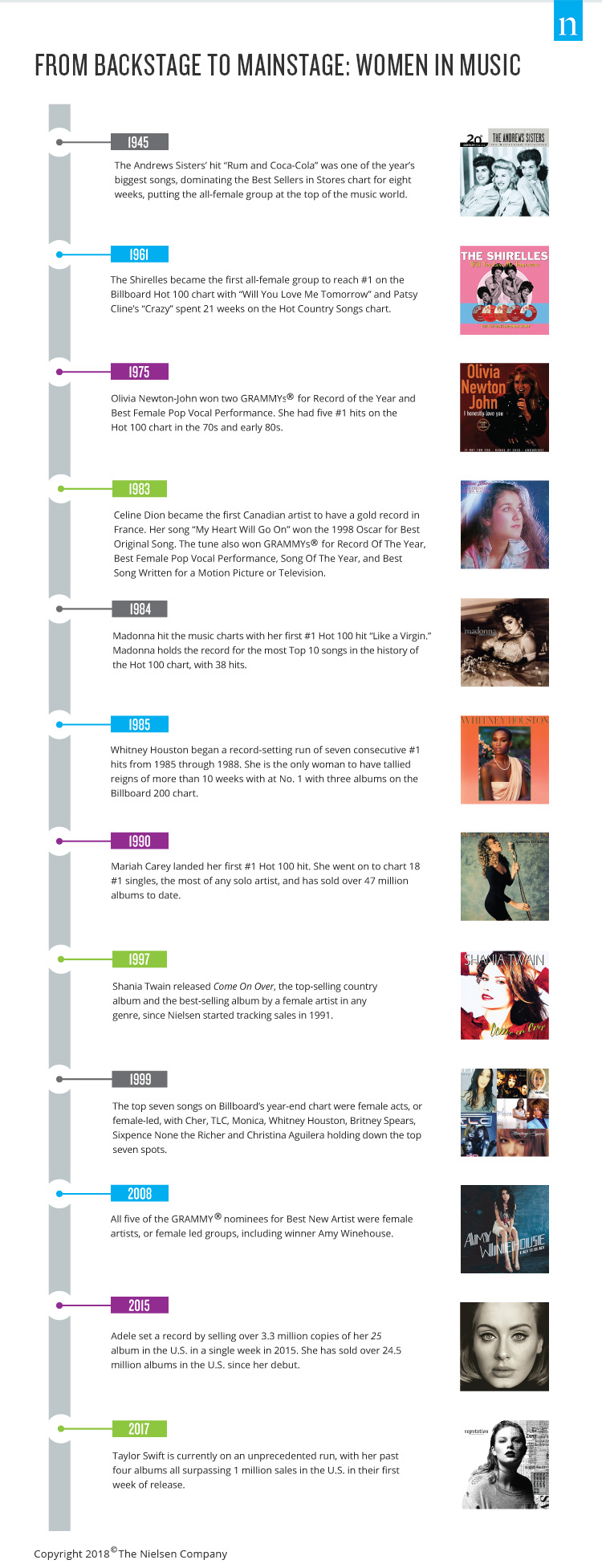To celebrate International Women’s Day 2018, we analyzed sales, streaming and radio airplay data from Nielsen and historic Billboard charts to demonstrate the strong and lasting impression that female artists have had on music.
From Helen Reddy’s early 1970s hit “I Am Woman” to Kesha’s star-studded performance of “Praying” at the 2018 GRAMMYs®, music has served as a celebration of female empowerment. While music formats and tastes have changed over time, one thing remains constant—the powerful voice of women in popular music.
1940s: Women Making their Mark in Music
Billboard’s popularity charts began measuring the biggest hits in the 1940s, a time dominated by Big Band and jazz artists like Jimmy Dorsey, Duke Ellington and Glenn Miller. But they weren’t alone, as a few female performers like Billie Holiday and the Andrews Sisters were also making their mark on the charts amid a largely male-dominated music landscape.
1950s: Rising with Rock n’ Roll
The 1950s ushered in the birth of rock n’ roll, a powerful new music style that predominantly kept men in the spotlight. But even in this male-dominated era, female vocalists like Rosemary Clooney, Patti Page and Doris Day were among the chart leaders of the early 50s. Things shifted a bit, however, when Bill Haley’s “Rock Around the Clock” debuted in 1955 and Elvis Presley began to dominate the charts in 1956. And by the late 50s, female artists were scarce at the top of the charts.
1960s: Country and R&B Breakout Stars
Music broadened in the late 1950s and early 1960s with the arrival of the Nashville sound and the crossover of country music into pop territory. Patsy Cline was a leader in this movement, and she had a string of hits from the late 50s to early 60s. Rhythm and blues also gained popularity in the early 60s, largely due to the success and influence of the Shirelles, who became the first all-female group to hit No.1 on the U.S. Billboard Hot 100 chart with “Will You Love Me Tomorrow.” While the Beatles took America by storm in the mid 1960s, the period also brought us the Supremes, one of the most successful vocal groups of all time, landing 12 No.1 hits on the Hot 100—a record for an American group.
1970s: Disco, Duos and Debby
While many think of disco when they think about the 1970s, the decade also spawned a number of prolific female-led duos like the Carpenters, Peaches & Herb, and Captain & Tennille, all of whom enjoyed great chart success, as did solo vocalists Roberta Flack and Barbra Streisand. Then, in the late 70s, Debby Boone’s “You Light Up My Life” topped the charts and spent a then-record 10 consecutive weeks at the top of the Billboard Hot 100. On the disco front, acts like Donna Summer, Gloria Gaynor and Sister Sledge became household names. Then in the late 70s, Olivia Newton-John garnered four GRAMMYs, five No.1 hits, 10 other Top 10 hits, and went on to become one of the world’s best-selling artists of all time.
1980s: Record-setting Recordings
Women ruled the charts in the early 80s, as female artists led the year-end Billboard song charts three years in a row: Blondie’s “Call Me” led the chart in 1980; Kim Carnes’ “Bette Davis Eyes” led in 1981; and Olivia Newton-John’s “Physical” led in 1982. And while Cyndi Lauper and Tina Turner launched successful releases in the mid 80s, Madonna’s first No. 1 hit “Like a Virgin” was a real game changer when it hit the charts in 1984. And later in the decade, Whitney Houston kicked off a record setting run of seven consecutive No. 1 hits, followed by Janet Jackson’s rise to superstardom in the late 1980s and early 1990s, when she set a record with 18 consecutive Top 10 hits.
1990s: Women Taking Center Stage
As the 1980s came to a close, women took center stage. In fact, female solo artists and groups comprising, or led by females, landed six of the top 10 Hot 100 songs of 1990. Mariah Carey made her debut that year and went on to chart 18 No.1 singles in her career, the most of any solo artist. But the U.S. charts weren’t just for Americans. Canada’s Celine Dion, the U.K.’s Spice Girls and Sweden’s female-voiced Ace of Base all had chart-topping hits. The millennium closed much like it started, as female acts and female-led were responsible for the top seven songs on Billboard’s year-end Hot 100 chart at the end of 1999. We also started to see another wave of female country-pop crossover hit makers in the late 1990s, including LeAnn Rimes, Shania Twain and Faith Hill; each placed songs in the top 10.
2000s: Genre Crossover Success
Genre-crossing continued in the early 2000s, as several popular female artists like Mary J. Blige, Ashanti, Beyoncé and Alicia Keys crossed over from hip-hop and R&B influences. American Idol debuted in 2002 and served as the launching point for Kelly Clarkson and Carrie Underwood, both of whom remain musical powerhouses today. In 2005, four of the top five Billboard Hot 100 songs of the year came from female acts and that trend continued in 2007 when seven of the top 10 (including all of the top four) songs came from female acts. In 2008, all five of the GRAMMY nominees for Best New Artist were female artists or female-led groups, including winner Amy Winehouse. As the decade closed, the top five Hot 100 songs of 2009, according to Billboard, were female acts or groups led by female performers: The Black Eyed Peas (led by Fergie) had two songs in the top five; Lady Gaga had two; and Taylor Swift had one.
2010 – present: Sales Success and Rising Stars
In our current decade, women’s voices in music are more powerful than ever. Here’s an example: In a single week in 2015, Adele set a record by selling over 3.3 million copies of her 25 album in the U.S. She also has sold over 24.5 million albums in the U.S. since her debut. We’ve also been introduced to Katy Perry, Ariana Grande, Lorde, Iggy Azalea, Meghan Trainor and Alessia Cara. And acknowledge Taylor Swift’s unprecedented run of surpassing 1 million sales in the U.S. in the first week of her last four releases.
Female artists are dominating the charts like never before, setting records, garnering recognition and leading the industry forward. These voices are coming from all areas of the world. Through all the different musical styles and all of the changes in how fans listen to music, the voice of the female artist is one that reaches a volume that will lead the music business into the future.

For insights about women in sports, read our Celebrating Women Olympians article.



